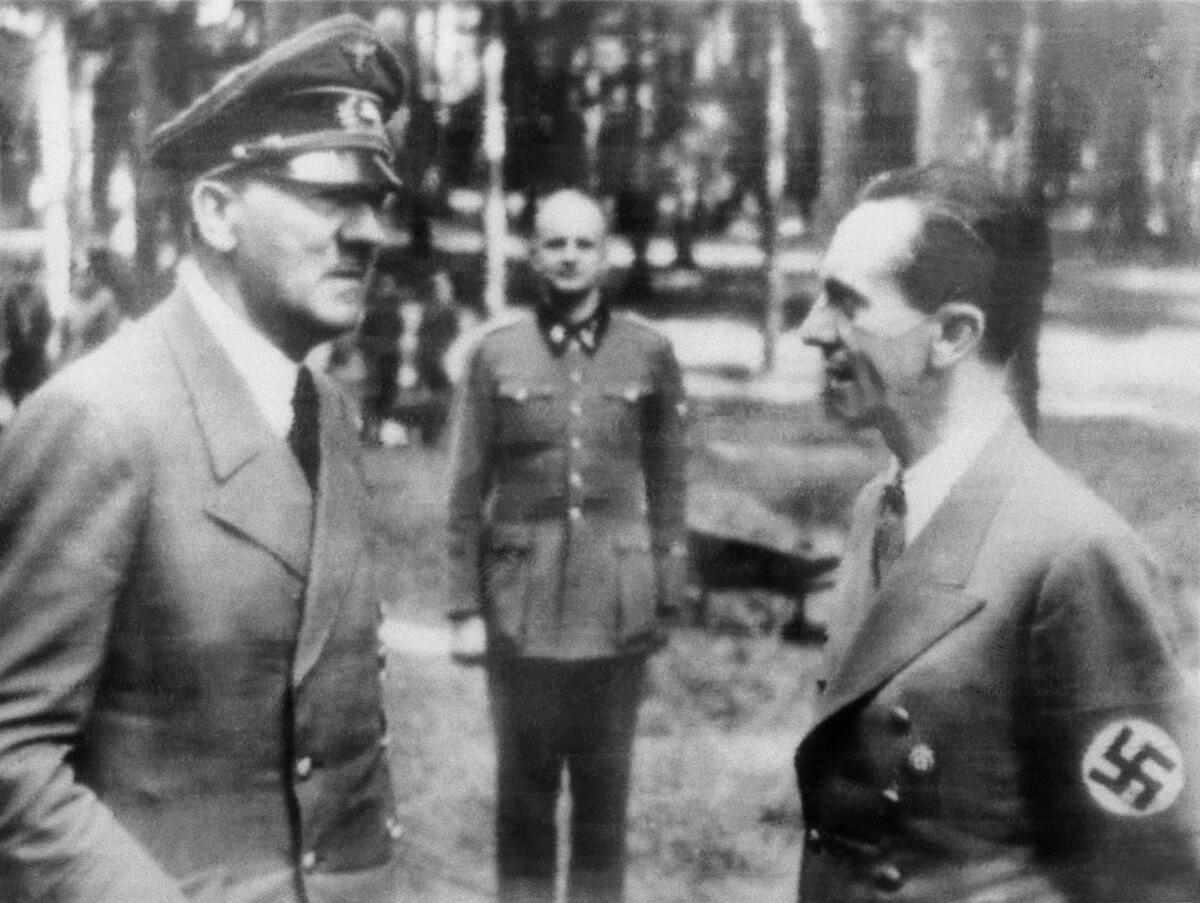Op-Ed: A history of the ‘Big Lie,’ from Plato to TikTok

- Share via
A long time ago, a respected social critic expressed concern that a new medium would lead to lying.
The year was 375 BCE, the critic was Plato and the still relatively new medium was the written word, which, despite his many reservations, he used to circulate his oral dialogues with Socrates.
Today, we’re again worried about the power of new media to facilitate lying. This time, it’s the internet, Facebook, Twitter and TikTok. But if you look back at history, lying is as old as humans (older really, since some animals practice deception). And every advance in communication down through history has facilitated it.
Plato, though he was concerned about the written word, wasn’t actually opposed to lying under all circumstances. In fact, he believed societies needed what he called “a grand lie,” a deception intentionally spun to serve a civic purpose, a great national myth that would help forge a nation’s identity.
The myth we believed for so long about George Washington and the cherry tree is an example of the Platonic grand lie. In the early years of the country, the United States felt the need for good founding lies and Washington, the tall, well-spoken, heroic founding father seemed the perfect subject.
In the sixth edition of his Washington biography in 1806, author Mason Locke Weems described young George chopping down a cherry tree and confessing to his father, “I cannot tell a lie.” But this parable on lying was itself a lie. It remained popular for generations, and ultimately outlived the book.
The printing press, invented in the 15th century, helped spread lies too, just as the written word had. After the English Civil War in the 17th century, lies defaming Oliver Cromwell kept the presses busy. In 1665, a fake cookbook, supposedly by Cromwell’s wife but full of fraudulent attacks on her husband, was published. The lying cookbook was invented.
One of the most successful examples of lying in print was a pamphlet first circulated in Russia in 1905. It was so clumsily written and so obviously untrue that it should have died quickly. Instead “The Protocols of the Elders of Zion” has been translated into many languages, is still being published and is widely available on social media today.
The “Protocols” claimed to be the stolen notes of a meeting of a secret organization of Jewish leaders conspiring to take over the world. There never was such a meeting because there never was such an organization. That the “Protocols” still survives proves the durability of unconvincing lies and the utter unoriginality of today’s liars.
With the growth of newspapers, new opportunities for lying emerged. Now a liar needed only to convince a reporter in order to spread a lie to a mass audience. At the beginning of World War I in August 1914, the French spread false reports of atrocities in German-occupied Belgium to motivate allied soldiers. A London Times correspondent reported that a German soldier had “chopped off the arms of a baby which clung to his mother’s skirts.”
Several subsequent inquiries failed to produce any evidence that such atrocities ever occurred.
Between 1928 and 1933, failed Soviet policies caused millions to die of famine in Ukraine. Pulitzer Prize-winning New York Times correspondent Walter Duranty reported, “There is no famine or starvation, nor is there likely to be.” Malcolm Muggeridge, a seasoned journalist also covering the tragedy, later characterized Duranty as “the greatest liar of any journalist I have met in 50 years of journalism.”
The Soviets tried to conceal the Ukraine tragedy by a lying technique known as “the Potemkin village.” A Potemkin village was a staged scene of prosperity for invited viewers. The respected French leader Edouard Herriot arranged a fact-finding mission to the Ukraine. On the day before his arrival, peasants were made to clean the streets and decorate the houses. Shop windows were filled with food, but the locals were not allowed to buy it or even to press too close to the windows.
There have also been American Potemkin villages. American cities have had paper constructions and lighting to make slums look better for sporting events.
The whole idea of a Potemkin village, by the way, is a lie itself. Gregory Potemkin, a government minister and lover to 18th century Russian Empress Catherine II, allegedly built prosperous fake villages to make the countryside appear more affluent for the empress’ 1787 boat tour of the Crimea. As it turned out, however, a Finnish diplomat and a Saxon one invented these stories to make it seem like the Russians were desperately covering up their failures.
Radio was a big step forward for lying. Father Charles Coughlin, a Catholic priest in Michigan whose antisemitic radio broadcasts were extremely popular in 1930s America, referred to the “Protocols” as evidence of a Jewish conspiracy. Coughlin was a pioneer in talk radio, spewing out lies on the radio with no one to contradict him.
But the great master of radio lying was Hitler’s propaganda minister, Joseph Goebbels. “It would not have been possible for us to take power or to use it in the ways we have without the radio,” he once said. He distributed radios to the public. Having one of these official radios was a sign of being a good Nazi, not only because they were decorated with swastikas, but because they were only capable of picking up Nazi Party frequencies.
But all sides were using the radio to get their stories out. In 1945, as World War II ended, Alexandre Koyré, a French philosopher and science historian, commented, “Never has there been so much lying as in our day. Never has lying been so shameless, so systematic, so unceasing.”
The exact same thing is being said today about the rise of social media. But there are differences now.
Social media celebrates amateurism. Any idiot can weigh in.
And it’s easy to use effectively. Donald Trump can put out an immense volume of lies on his own and dispatch them to tens of millions of people in a moment. Goebbels required a staff of nearly 1,000 professional liars.
And there is something else: Only a small portion of listeners believe a lie when they hear it. If you lie to 100 people you might get two or three believers, and if you lie to thousands, you might get hundreds. So what happens when you lie to millions on the internet?
Mark Kurlansky is the author of “Big Lies: From Socrates to Social Media,” which will be published on Sept. 27.
More to Read
A cure for the common opinion
Get thought-provoking perspectives with our weekly newsletter.
You may occasionally receive promotional content from the Los Angeles Times.










